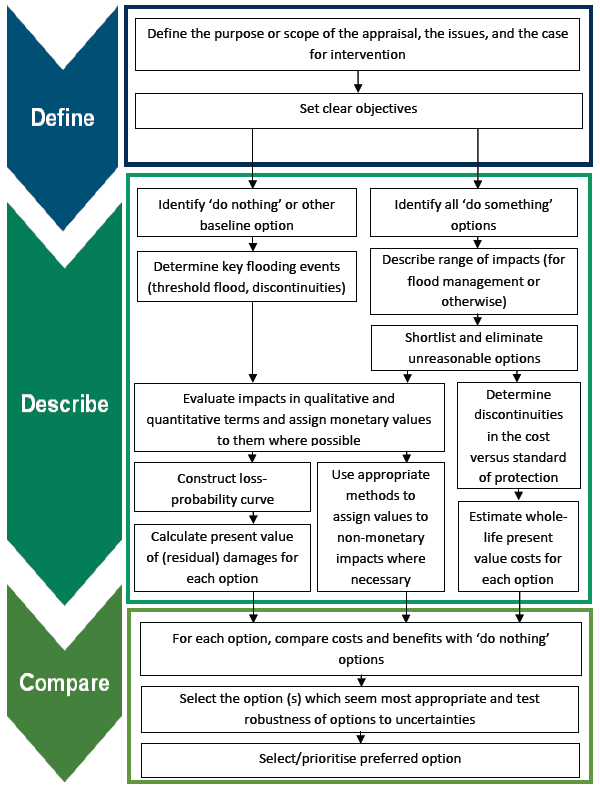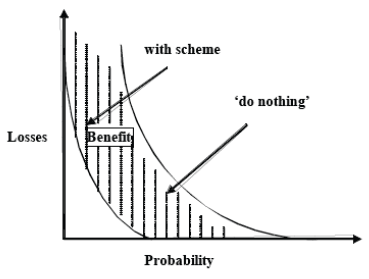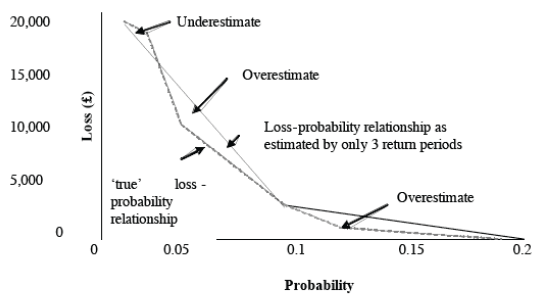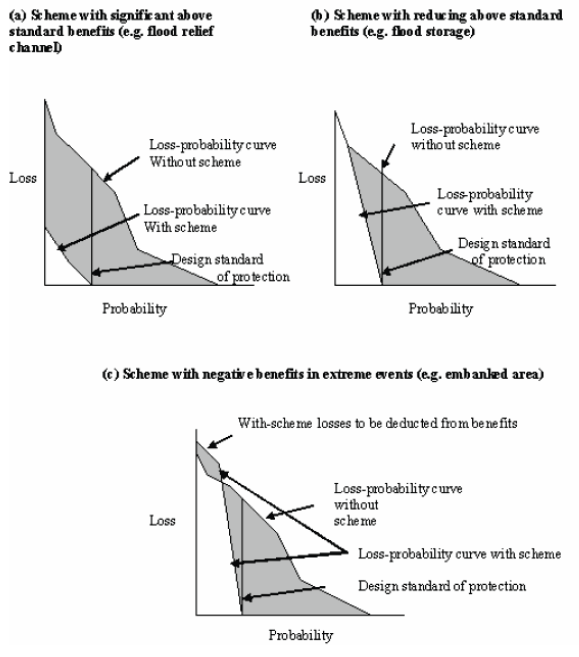Flood protection schemes - assessment of economic, environmental and social impacts: guidance
Guidance for local authorities on chapter 5 project appraisal of flood protection schemes under the Flood Risk Management (Scotland) Act 2009.
6. DESCRIBE: Describing Flood Protection Benefits
6.1 The benefits of flood protection schemes are calculated as the difference between the expected value of flood damage with the option being evaluated, compared with flood damage and losses in the 'do nothing', or where relevant 'do-minimum', case. A summary of the procedural steps required is shown in Figure 6.1.
Calculating flood damages
6.2 The damages caused by a flood are a function of its depth, duration, velocity, and its sediment and pollutant loads. In the UK, floods are usually relatively short in duration and involve low velocities. Consequently, the primary determinant of the losses for a particular property is the depth of flooding. However, in steep or flashy catchments, or where protective structures fail, flood velocities can be high. This may result in additional losses from partial or complete structural failure of properties.
6.3 Sediment, debris and sewage borne by a flood may affect the costs of cleaning up after the event. Further, flooding by saltwater generally causes more damage than the equivalent depth of flooding by freshwater.
6.4 When considering the benefits of a flood protection option due to changes in consequences, there are several potential approaches that can be used to capture this information:
- Consider whether the depth of flooding would change;
- Consider whether the timing of flooding would change (this could be due to change in the onset of flooding or erosion);
- Consider whether there are benefits in terms of the duration of impacts (for example, the time over which floodwaters are present on land could be reduced, people may be able to move back into their homes more quickly. This could reduce direct damages, for example, by reducing time for land/habitats to recover or the cost of temporary accommodation and stress due to disruption of family life);
- Consider whether those at risk would change (assess whether more vulnerable people, habitats or higher quality agricultural land would be protected reducing risk to life, biodiversity impacts or impacts on agricultural outputs);
- Consider whether floodwater velocities would be decreased (this, in conjunction with flood depth and rate of onset, could reduce risk to life, risk of scouring of habitats or land with implications for increased recovery).
Figure 6.1 Framework flow chart for flood protection appraisal

Loss-probability relationship
6.5 The benefits of flood protection are calculated as the expected value of annual flood losses averted. As floods are assumed to be random events, it is not possible to predict when they will occur. The expected value of annual flood losses is calculated as the probability of a range of events multiplied by the loss that such an event would incur. In practice, the losses are measured by the difference in the areas under loss-probability curves for the 'do nothing' and with scheme options. This difference in area is the expected value of the reduction in flood losses each year over the life of the scheme; the average annual benefits (figure 6.2). These are discounted over the life of the scheme to give the present value of the benefits.
Figure 6.2 Determination of average annual benefits

Changes over time
Identifying the probabilities of failure
6.6 Changes in probability are central to the cost-benefit analysis. For flood protection schemes, the 'do something' options reduce the probability of flooding. Commonly, the probability changes over time; for example, the likelihood that an existing flood embankment will fail may well increase with time. Climate change, development of catchments, and alterations in ground level may also change the probabilities of events of particular magnitudes. Chapter 6 provides guidance on the use of risk assessment in project appraisal, and the derivation of probability functions
6.7 Where changes are anticipated in the expected probabilities of flooding over the life of a scheme, it is necessary to calculate a number of different average annual benefits corresponding to the different conditions. As noted above, such changes could include those associated with climate. For example, physical changes in the catchment could also affect probabilities. Further, changes over time in the use of the flood plain may alter the losses expected from a flood of a given magnitude. In such cases, average annual benefits should be calculated for appropriate years, and values interpolated for intervening periods.
The upper limit to losses
6.8 Care should be exercised where the total present value of losses exceeds the current write-off value of the asset. In the case of domestic or commercial property, it will usually be prudent to assume that the long-term economic loss cannot exceed the current capital value of the property. In the case of other assets, such as roads, railway lines, pipelines or cables, some very large values can be generated for long-term disruption. It will often then be reasonable to assume that the maximum economic benefit derived from flood defence is equal to the economic cost, depreciated to allow for the age of the existing asset, of reconstructing an equivalent facility at a higher level, or on an alternative alignment, which avoids the flood risk.
Sampling the annual exceedance probabilities
6.9 The loss-probability curve is generally calculated using only a very small sample of the possible AEPs that might be considered. The overall form of the curve, and the area under it, is derived by drawing straight lines between the calculated points. This can, potentially, result in wrong estimates of the area under the curve ( figure 6.3). In this illustration, the choice of AEPs, when compared to the 'true' relationship, has resulted in a significant overestimate of the overall losses.
Approximation of loss curves
6.10 Determining how many and which AEPs to include is a sampling problem. The aim is to obtain a reasonably close approximation to the loss-probability curve representing an infinite number of flood exceedence events if these were to be modelled. The ideal AEP events to use are those located at discontinuities on the curve.
High probability events
6.11 First, it is important to locate the AEP of the threshold flood event: that is, the most extreme flood that does not cause any damage. Secondly, engineering judgment should be used to assess where the discontinuities are likely to be. For example, they can be expected to occur when an existing natural or man-made structure is overtopped, or a culvert or bridge reaches its capacity. Thirdly, the greatest proportion of benefits generally arises from the greatest probability floods. Consequently, the sampling should usually be biased towards these events. A few judiciously chosen events at appropriate points of discontinuity will generally produce a more realistic result than a larger number at standard intervals.
6.12 If a software package is being used to calculate the flood losses, it is simple to plot a flood-stage/damages curve for a large number of flood stages. Discontinuities on the curve indicate those events that should be included, provided the information that produced the discontinuities is accurately provided in the data input.
6.13 In terms of good practice:
- The benefits should be calculated using a minimum of 3 events (preferably 5) and the choice of those events should be considered carefully;
- One of these events should normally be the threshold flood event.
Figure 6.3 Accuracy of estimation of the loss-probability curve

Above-design-standard benefits
6.14 The notional standard of protection (design standard) afforded by a flood protection scheme will usually be defined in terms of the onset of significant losses. However, many such schemes will have some effect on the losses from all floods, even the most extreme, and all of these impacts should be taken into account. While it may not always be practical to model the extent of flooding from all events up to the probable maximum flood, it should be possible to draw logical inferences as to how the scheme will respond to such larger events. From this, the likely shape of the loss-probability curve can be estimated. It is important to ensure that the range of events considered is appropriate for fair comparison of all options.
6.15 For example, schemes that increase the capacity of a river channel will result in less water flowing out of the bank for all events with the scheme than without. Consequently, the losses from any particular event with the scheme, should never exceed those without the scheme, and will normally be less. Two examples are illustrated in Figures 6.4(a) and 6.4(b). In both cases the shaded areas represent the total average annual benefits.
Figure 6.4 Estimation of above design standard benefits

6.16 For other schemes, for example those involving walls and embankments that may be overtopped, losses in less probable events can be more severe than if no scheme existed. The duration of flooding may be increased, or the velocities of flow resulting from a failure may be greater than from the natural rate of rise of the flood (Figure 6.4(c)). In this case the negative benefits above the design standard should be subtracted to derive the net average annual benefits.
6.17 For some schemes, above-design-standard benefits can be a significant proportion of total benefits. They will also have an impact on the incremental benefits of different design standard options. For instance, part of the incremental benefits of a nominal 1% AEP scheme may already be realised in the benefits of the 2% AEP scheme. This illustrates the importance of considering the full range of benefits in all decision-making.
Climate change adaptation
6.18 A changing climate poses serious challenges and risks for managing flooding in Scotland. The impacts of climate change include the potential increase in intensity, severity and frequency of rainfall events affecting flooding in fluvial catchments and urban surface water systems. It may also affect sea levels, storm surges and wave actions, with potential associated impacts on flood risk.
6.19 The appraisal process should seek to fully understand risk in a changing climate and should be in accordance with the Scottish Government's guidance on Public Bodies Climate Change Duties (reference 19) and the objectives of the Climate Change Adaptation Framework (reference 20) and accompanying Water Environment and Resources Action Plan (reference 21).
6.20 The likely effects of the changing climate should be consistently taken into account in appraisals using up to date robust evidence. The UK Climate Projections (reference 22) provide projections for precipitation, sea level rise and storm surges for the UK until the 2080s. Modelling will be required to estimate the potential impacts of the projections for a specific flood risk protection scheme. Estimates of changes to peak river flows may be available from other sources- the appraiser should use their judgement to ensure the most up to date robust evidence is used.
6.21 A decision will often need to be made on whether to design now for climate change or to design in a way that allows adaptation at some point in the future. This decision will depend on the nature of the problem. For example, planning led intervention or a 'no-regrets' action might adopt a precautionary approach. If a managed/adaptive approach is aimed for, sensitivity analysis for climate change needs to be undertaken both at the earliest possible screening stages in the appraisal, and after the final options have been short listed. Interventions and approaches that are not sustainable in the long-term should be avoided.
Freeboard
6.22 Freeboard is a factor of safety in flood protection design (usually expressed as height above flood level) and should only be used to take account of uncertainty in scheme performance. The use of indiscriminate standard freeboard allowances can lead to problems, particularly in relation to differential standards of protection. Ideally, defence crest levels should be determined from a risk-based approach (see Chapter 6).
Simplified assessment
6.23 For very small schemes, or preliminary studies, properties can be grouped for the purposes of damage estimation. Estimates can then be used of the likely average depth of flooding in each group of properties. This procedure should be applied for each of a minimum of two flood events above the threshold flood. The average loss for a residential property at each of those depths, multiplied by the number of properties in each group, can then be used to derive the loss-probability curve. For a very basic assessment, it is possible to consider the average benefit of protecting a residential property. The Flood Hazard Research Centre estimate that the annual average damage to an average house with no flood warning and no flood protection is £5,393 (reference 5).
Contact
There is a problem
Thanks for your feedback